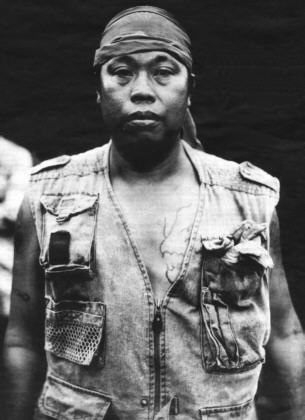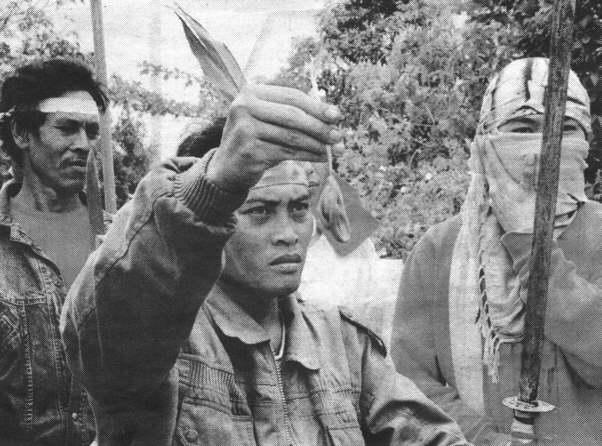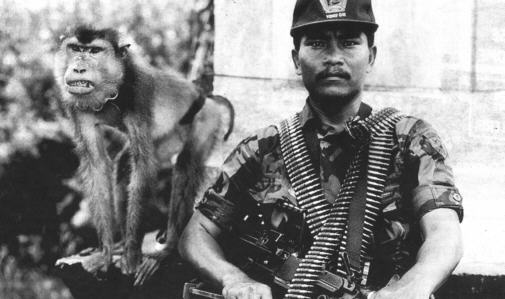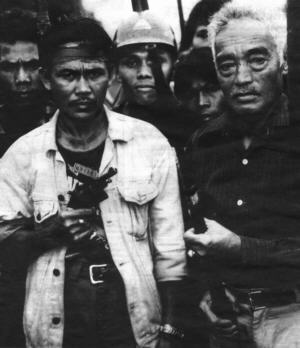| HERE BE CANNIBALS |
| REPORTS OF CONTEMPORARY CANNIBALISM IN BORNEO |
Sambas was 50 miles from Singkawang, but even at that distance it was obvious that something awful was happening in the town. Our driver heard the rumours early the following morning; as I was eating my breakfast, he timidly approached to announce that he would not be able to drive us that day. By the time we found another Jeep it was after 9am, but not a shop or business in Singkawang was open.
“Sambas?” said the officer at the army checkpoint, and when we nodded he shook his head disbelievingly as he raised the bamboo barrier. It was March 21, 1999, a Sunday.
There was no ordinary traffic on the road. The only vehicles were motorbikes, carrying two or even three riders, buses and large trucks with slatted wooden sides. Each was packed with Melayu dressed raggedly for war. They clung to the roofs of the buses and the running boards of the trucks. They raced one another with crazy speed and the warriors leaned out and waved as they overtook us, shouting, “Sambas, Sambas.”
People fell into two categories that day: those who could not be induced to go near Sambas, and those who could not get there fast enough.
At a town called Pemangkat, we stopped and photographed a group of warriors. It was appalling to see how young they were. The atmosphere was closer to that of a school outing than a war party, an outing which had been hijacked by a gang of horribly overexcited bullies. At the sight of the cameras they pranced and posed. Most carried small sickles, some had mandau (swords), a few had longer swords or spears, and one carried a hunting rifle. With care and ingenuity they had fashioned uniforms for themselves with ribbons and bandannas, scarves and balaclavas. One young boy wore a strip of red cloth covering his face into which he had cut two eyeholes. In his T-shirt and his shorts, with his bad teeth and his childish grin, he looked like a naughty boy dressed up for Hallowe’en.
Beyond Pemangkat, we passed rows of burnt and smouldering houses by the side of the road. Distant columns of smoke rose up from the jungle, each one of them representing another Madurese village. The new driver knew all their names and pointed them out as we passed: Selekau, Setimbuk and, far down towards the sea, Segaru, the island were the Madurese refugees were awaiting their Dunkirk. Had the boats come to rescue them in time? Or had the Melayu gone in and “finished” it, as they had promised?
Ten minutes before Sambas thick billows of smoke were visible, rising from a point close to, but outside, the town. We passed through an army checkpoint; the soldiers were doing nothing to stop the trucks of arriving warriors. Budi, my Chinese guide, asked the name of the place from where the smoke was billowing, and the officer told us it was a Madurese hamlet named Suka Ramai. “It is a strange name,” said Budi, “Suka Ramai. The words mean ‘I love noise’ or ‘I love trouble.’”
Sambas was a small market town, the usual agglomeration of wooden homes and low concrete commercial buildings shaped around a square. The metal shutters on the first-floor shops were all drawn down and padlocked. Not a single person was to be seen outside. At a T-junction on the edge of town, a massed body of men had gathered: older men than the imps in Pemangkat, big, burly men with long knives and a dozen rifles between them. To the right, a narrow road led towards Suka Ramai.
Half a dozen reporters and cameramen were standing uncertainly at the junction. We stopped the Jeep and cautiously walked towards them.
A man on a motorbike emerged from the direction of the smoke, and came to a stop. In one hand he brandished a curved sword and in the other he held out an object attached to a length of string. It was pink and delicate and it took several seconds to understand that it was a human ear.
The man dismounted, kicked out the stand on his bike and sat on it facing us. A cameraman and two photographers took up positions in front of him; he brandished the ear like a medal, and held it still so that they could focus the lenses. He wore a yellow headband daubed with paint, and there was blood on the sleeve of his jacket and on the blade of the sword. He was shouting into the cameras in a barking, staccato manner. Was this the state of possession, the battle trance about which I had heard so much? He was a handsome man, with muscular brows and shapely lips. As he spoke I noticed his teeth, which were very white and even. I stared at the small dainty ear and began to feel as if I was falling into a trance myself.
“What does he say?” I whispered to Budi. “He says: ‘We don’t care about your race. We don’t care about your religion. Christian, Muslim, Buddhist, Dayak, Melayu, Chinese or Buginese – all of them are welcome here. We just don’t want Madurese. All the Madurese must leave.’”
“Ask him what is happening up there,” I said. Budi asked. “He says go and see for yourselves.” The man with the ear, pointing up the road, towards the smoke, said: “Silahkan, Silahkan.” Go ahead. Be our guest.
A mile of fields lay between Suka Ramai and the spot where we stood. The road across them ran dead straight. The cameramen and reporters exchanged hesitant glances. I had never felt simultaneously such extremes of eagerness and reluctance. My body felt light, as if I might float away. It wasn’t fear, because there was a weird absence of any personal threat. It wasn’t suspense: it was obvious what was happening up the road. But it was impossible to turn back.
The driver refused to take the Jeep any farther. As we began to walk towards “I Love Trouble,” another truck overtook us and the warriors in the back cheered and waved their blades. A man on a bicycle passed by in the opposite direction, with a little girl on the handlebars; both waved and smiled. The surface of the road was in good condition; we passed one patch which was sticky with blood.
A scattered group of warriors appeared from the direction of the village, jogging towards us out of the smoke, waving their weapons. A man carrying a spear ran up to me, grinning and shook my hand. “Anti-Madura!!” he shouted. “Madura, no! No Madura!” Now there were hundreds of young men streaming down the road past us. They were all smiling, and panting with exertion and excitement. More of them stopped to talk.
Ask them where they come from, I told Budi. “Pemangkat,” said one boy in a T-shirt bearing a map of the London Underground. “But I haven’t been there for seven days. We have been hunting the Madurese people.”
What do you do if you find them?
“We kill them directly, then take the head and chop it.”
Why do you chop the head?
“It is our tradition,” he replies. Then a boy in a white vest was walking towards me, holding a human arm, severed below the elbow. All the fingers and much of the skin had been stripped off the hand. Bone and muscle bulged out of the other end.
When the warriors had gone, Budi said: “It is not their tradition. It is a Dayak tradition, but they are Melayu.” Soon I could smell the houses burning. There were perhaps a dozen houses in Suka Ramai, and all of them were in flames. There had been a hundred Madurese holding out here, and at least a thousand Melayu in the raiding party.
A few of the Madurese had stayed to put up a fight; after two of them were shot, the others had run off into the jungle. Some of the raiders had stayed in the village to chop up and divide the two bodies; the rest had crossed the fields to hunt the fugitives in the forest. But they had made a clean escape, and the tired thirsty Melayu were returning to the burning village. We were arriving at the tail-end of the hunt; the fun was over for the day. A battered pickup halted beside us, and a Chinese man began unloading boxes of bottled water and handing them out to the warriors. There was nothing else to do, so we walked back along the road. I felt obscurely disappointed, as if the point of the afternoon had passed me by. We climbed into the Jeep and drove back into Sambas to find water ourselves.
In the market square a few of the young warriors were standing around, and a single shop was open. There was a stand selling the kebabs called sate; near by smouldered the embers of a fire. Among them was a charred human femur. Budi noticed it at the same time as me, and he suddenly looked stricken. His lips trembled and he was on the edge of tears.
“Let’s go, Richard,” he said in a low, strangled tone. I walked quickly to the shop to buy water and cigarettes. As I was fumbling for the money, a tall man in a yellow headband walked over from the sate cart. On his belt hung a rusty handgun, as well as two of the bulging plastic bags I had seen the day before. In greasy fingers he held a piece of grey, fibrous, partly cooked meat impaled upon a stick of wood. He pulled off a piece with his teeth and chewed it. His face was a foot away from mine.
He held the kebab out to me, and smiled. “Silahkan!” Please eat.
The other boys in the square had gathered round and were laughing. “Silahkan! Silahkan!”
“No, thank you.” Budi walked up, looking agonised. “Please, Richard, let’s go.” The man continued to push the meat at me, talking excitedly. “Tell him no, I don’t want it.” But he wouldn’t take no for an answer, as he waved the meat in my face.
I experienced again the sensation of light trance, and of gravity failing around me. I thought about how easy it would be to take the meat, and to eat it. I thought about the animals which I had eaten over the years; horse, dog, monkey, snake, snail, slug. I remembered in particular the monkey, which had been grilled over a fire in a jungle village. Its meat had been tough and gamey, but afterwards I had seen a relic of it: a simian right arm, hand and portions of a rib-cage. The skin was charred, but patches of the fine grey fur were still visible and the hand had ten delicate fingernails, like the nails of a newborn baby. How close was I to being a cannibal? My dreaminess deepened as I pondered the consequences of my actions in the next two or three seconds: I, a cannibal... But the piece of meat looked cold and unappetising. I needed to drink water before I could think about eating.
“Ha!” said the kebab man with a cackle. He pulled the meat away and stuck it into his mouth, and I felt my knees going cold with relief.
There were so many questions I could have asked. I asked the first one that came into my head.
“Delicious,” he said, when Budi had translated. “Like chicken.” We walked to the Jeep, and the kebab man followed us, with a group of young Melayu, all laughing and jabbering and pointing behind them.
“Oh no,” said Budi quietly. What is it, I ask? “They’ve got more... meat. They want to show it to us. They want us to eat.”
“Let’s just go,” I said, but the hands of the Melayu kebab man were on my shirt and he was tugging me back from the open door of the Jeep. “No thank you” I said, trying to keep a smile on my face as I unpicked his fingers. “No thank you. Let go.”
The driver was frowning and sweating as we struggled to close the doors. Then the engine wouldn’t start. Twice, it rumbled and grated and then died. Budi was muttering something, perhaps even a prayer. Outside, the kebab man and his friends were tapping on the window, and bouncing ecstatically up and down. Then the engine started up, and we began to reverse slowly into the road. The men outside were miming the action of a pair of chopsticks over a bowl of rice. They were shouting words I understood: “Makan! Makan!” and “Silahkan!” They chased after the car as we drove away.
Makan! Silahkan!
Dinner time! Be our guest!

|
| Among the Cannibals |

|
| A Melayu warrior holds up the ear that he has taken from a dead Madurese in the conflict on Borneo in 1999 |

|
| A warrior with a monkey at the town of Sambas where atrocities took place |

|
| Melayu with their weapons preparing to hunt down Madurese |
Richard Lloyd Parry, The Time of Madness, Jonathan Cape, 2005.
This excerpt with photographs appeared in The Times, T2 section, 29 March 2005.